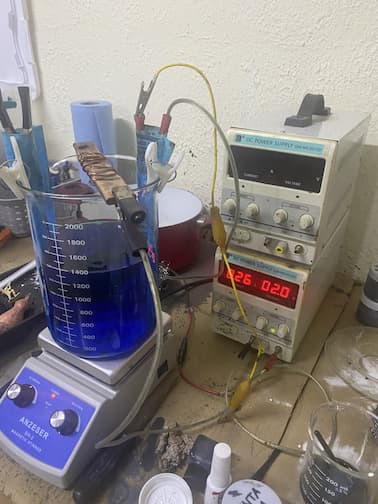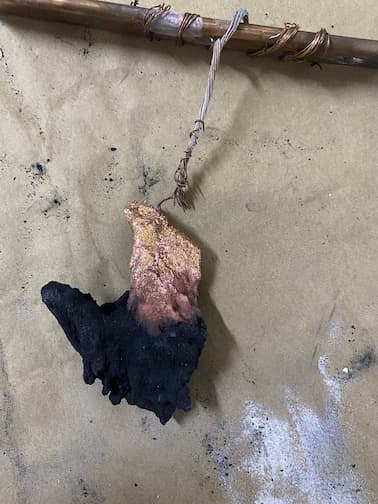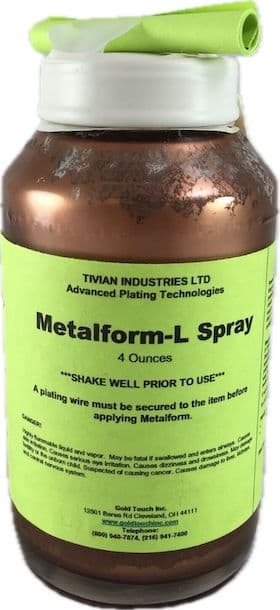
-----
Copper-plating of leaves and bark
Q. Copper electroforming not spreading all the way.
Hello! I have recently started to experiment with copper electroforming in hopes of getting familiar with the process and eventually start plating in silver.
I have had certain bumps in the road and have watched most of youtube's content on the matter but don't seem to find anyone with my problem.
I started my first experiments about two months ago by electroforming on metal screws, and after I did about 4-5 tests I moved on to try conductive paint. Everyone on the internet swears by Mod Podge and graphite powder as the best way to make your own paint, but for the life of me, whenever I've tried to use it, the paint garners no conductivity whatsoever. I don't know if it's the graphite powder I'm using, but it hasn't worked at all. What seemed to be working was India Ink with that same graphite powder. I painted on a plastic subject and the results were not perfect but they were insightful for further testing, tweaking the ratio of graphite to ink and whatnot.
Now, I have tried to electroform on a piece of tree bark (I understand it is ambitious to try out organics this early in the game, but curiosity got the best of me).
First I sealed the tree bark with three layers of Mod Podge, and then I coated it with India ink and graphite powder mix (about 60-40 ratio, favoring on the powder and then diluting it a bit with distilled water for consistency). The result was a very lustrous and satisfying top section of electroforming, and the bottom section of the tree bark was left alone, nothing happened to it.
Also, it is important to point out: I've noticed that every time I dip objects into my bath that have been coated with the India ink mix, there is some fizzing and bubbling, then some flakes of the conductive paint fall off, resulting in me having to filter my bath every time I want to use it. Yet, there is still a visible layer of paint on the subject and most of it electroformed.
I have attached a picture to further illustrate my troubles, as well as a picture of my power supply. This particular piece was set up for 5 hours in that amperage.


I hope someone has some helpful insights as to what could be my problem or any ideas on how to solve it!
Angie Garcia- Monterrey, Mexico
March 29, 2022
A. Hi. I suppose it is possible that for some reason your graphite is not conductive; also I think you want to mix your ink or graphite with Mod Podge so it doesn't just fall right off.
But it not 'spreading' may be understandable and proper. Electricity essentially takes the path of least resistance. If the back is not facing an anode it will plate very little. Further the conductivity of your ink may be insufficient to properly carry current from your copper wire to the other end of the bark. Any reason you can't connect copper wire to both ends of your piece of bark?
Luck & Regards,

Ted Mooney, P.E. RET
Striving to live Aloha
finishing.com - Pine Beach, New Jersey
Ted is available for instant help
or longer-term assistance.
![]() Thank you very much! I will try by changing the variable of the graphite and try with another brand, as well as adding copper wire to the bottom of the bark as well.
Thank you very much! I will try by changing the variable of the graphite and try with another brand, as well as adding copper wire to the bottom of the bark as well.
Best regards,
Angie
- Monterrey, Mexico
A. Forget graphite based paint try fine copper or bronze powder - no need for paint. 19th century electroformers never used graphite based paint, only graphite powder (very messy and dirty job ).There are many download free old electroforming and electrotyping handbooks on web (archive.org website ). Hope it helps and good luck!
http://29aqcgc1xnh17fykn459grmc-wpengine.netdna-ssl.com/osg-postprints/wp-content/uploads/sites/8/2019/12/osg024-026.pdf ⇩
Very good short and clear article on small size copper electroforming.
- Cerovski vrh
Ed. update Nov. 2023: Unfortunately that site no longer exists.
⇩ Related postings, oldest first ⇩
Q. Dear Experienced Finishers,
We are interested in attempting to do an electrolysis experiment for homeschooling science. If you have any advice for us, we would be very grateful. My four kids are fascinated with what they have read, and are eager to put it into practice (on a small scale!). What we have is 2 wires with alligator clips, a 6V battery, about 1/4c. copper sulphate
⇦ on
eBay or
Amazon [affil link] crystals (from the local high school teacher), a piece of copper (a plumbing fitting) and a desire to try to make copper plated leaves. Do we need colloidal to make the copper adhere to a dry leaf? If so, where could we get a small amount? What concentration of electrolyte solution should we prepare? How long might it take to get a leaf capable of being mounted for a decorative pin, for example?
Thank you for your time.
Sincerely,
- Peacham, Vermont, USA
2003
A. I applaud your ambition and enthusiasm, Mium :-)
We have an FAQ, "How Electroplating Works", which includes experiments of zinc plating of pennies and copper plating of quarters or keys which they might try first. Although schoolchildren can certainly demonstrate electrochemical principles by doing science projects involving electroplating which render an intriguing color change -- it's not heavy, functional, robust, shiny, attractive plating. Doing difficult to plate objects like leaves and, using a toy electroplating setup to produce jewelry-quality plated leaves, might be a bit unrealistic as their first project. We always suggest trying to plate on easy metal substrates first as a way of learning step by step.
But prove me wrong please! The first step would be to lacquer the leaves to render them waterproof since plating solutions are water-based. You could try several very thin coats of Krylon. Others have used thinned glues like Mod Podge.
Then you need to metallize them with a colloidal copper or silver suspension available from Acheson Colloids or Sierra Silver, and probably Amazon. Copper paint from the hardware store may be good enough though :-)
Electrical wire rather than a plumbing coupling would be a purer source of copper, but whatever. 6 volts is far too much voltage though; 3 volts is way more than enough, and perhaps too much. 1-1/2 volts would probably be better. If you can do it safely, mix the copper sulphate crystals into diluted battery acid
⇦ on
eBay
or
Amazon [affil link]
. I'd try diluting the acid into 5 parts of water, and add enough of the copper sulphate until you have a rich dark blue color.
It's worth a try, I suppose, but if the kids are not yet teenagers, I think they'd probably be satisfied with the plating on coins idea, and would prefer success on a coin project to possible failure on a leaf project if it's too big a leap for a first attempt :-)
Good luck!

Ted Mooney, P.E.
Striving to live Aloha
finishing.com - Pine Beach, New Jersey
Ted is available for instant help
or longer-term assistance.
Q. How would you dispose of this solution, as it is a bio-toxin? Is placing a piece of 00 steel wool
⇦ on
eBay or
Amazon [affil link] into it until the solution is relatively clear, good enough to neutralize the toxic constituents enough to (hopefully not), have someone pour this down the drain?
Or, should it be then allowed to evaporate to dry salts, then taken to an appropriate disposal venue? I'm sure this should be the most important factor to consider when experimenting in the home. I just hope people are not dumping these hobby solutions into the water table.
- Kelowna, B.C., Canada
A. That's a good point to raise, Jeff, and it's been raised here lots of times.
Most of the students doing plating are working with vinegar ⇦in bulk on eBay or Amazon [affil link] , and the amount of copper dissolved in their dessert dish is about the same as they'd generate in washing a copper-bottom pot. From an actual pollution standpoint it can probably safely be ignored; but school projects should educate kids in doing things right, not in making excuses. Waste treatment should be part of the project, so the steel wool [affil link on Amazon] sounds like the right idea.
In the case at hand, a quarter cup of copper sulphate, we are talking way way more copper than would result from washing a pot or from a vinegar experiment, but less than people routinely pour down the drain as root killer. So I'd say precipitate it on steel wool and then dump it. (N.B. -- again, that's if you are a student; if you are a hobbyist you need to treat your waste as hazardous waste. Remember: "Toxic is a matter of statute, not opinion").

Ted Mooney, P.E.
Striving to live Aloha
finishing.com - Pine Beach, New Jersey
Ted is available for instant help
or longer-term assistance.
Q. I was just wondering where I can find the materials for an electroplating experiment. Also you talked about a leaf being plated, where could I find the solution for that experiment?
Thanx,
- Orange, California
2003
A. Melissa, our FAQs address the issue of electroplating for students, and instruct you to use readily available materials like vinegar.
Plating of a leaf is beyond the abilities of most young students doing a science project, although we've listed some potential instructions and suppliers of the required metallizing solutions just above.

Ted Mooney, P.E.
Striving to live Aloha
finishing.com - Pine Beach, New Jersey
Ted is available for instant help
or longer-term assistance.
Q. I am getting an electroplating set up and want to start making electroplated leaves and such for jewelry. I am trying to research how to make the leaves iridescent after copper electroplating is done. I'm willing to purchase a book or take a class. I just can't find what best suits my need. Thanks.
Kim Foschini-Yahraus- Mesa Arizona
April 10, 2013
Q. Hello everyone,
I am an artist new to electroforming/electroplating. I am working on a sculpture and would like to include electroformed leaf skeletons. Along with copper, gold and silver many artists who make electroformed leaves offer a gorgeous color called "iridescent copper". I have done a lot of research but have not been able to find any information about how to create the iridescent copper effect. One web site said that it was a "combination of 24K gold and copper". Unfortunately, this is not enough information for me to go on. Does anyone have any idea how this effect is achieved?
Any information would be greatly appreciated. Thanks.
- Mount Pleasant, South Carolina, USA
April 20, 2013
A. Lora, Kim,
Part of the problem I'm having in trying to figure out how to provide you advice is that I have no good frame of reference for what you want. Is there any chance you can provide us with some links or pictures to what you are trying to do?
One more additional note, this may be a patina, please take a look at:
www.ganoksin.com/borisat/nenam/iridescent-patina.htm
Blacksmith - Boone, North Carolina, USA
Q. Hi Marc,
Thanks for responding!
Here are a few links that show the "iridescent copper" effect:
1.Link to amazon product .
2.Esty products
www.etsy.com/listing/117098230/necklace-with-iridescent-copper-dipped?ref=market
&
www.etsy.com/listing/79860863/real-sugar-maple-leaf-in-iridescent
3.
www.fireandice.com/copper-plated-iridescent-birch-large-pin-pendant.html
I hope these links give you some idea of what I am talking about.
Thanks for the iridescent patina link. I will have to give it a try and see if it gives the "iridescent copper" effect that I see on other websites.
Thanks
- Mount Pleasant, South Carolina, USA
A. After taking a look at the pictures it does appear that finish is indeed the product of an oxidation reaction. The previous link I provided to the patina recipe should provide you a similar result.
Marc BanksBlacksmith - Boone, North Carolina, USA
A. Iridescence on copper metal can be very easily realized using H2S (hydrogen sulfide). You can obtain all the colours of the light spectrum with different times of contact between H2S gas and the copper metal.
Mario Voltaggio- Rome, Italy
April 9, 2014
A. In answer to the original question, yes you can. Admittedly not as easy as electroplating which involves metal to metal, plating onto leaves, acorns, etc. is called electroforming; with an acorn you can rub over it with a soft graphite pencil then plate in the same way as metal to metal but as leaves are delicate they need to be carefully slow dried then sprayed with colloidal graphite thoroughly before plating. I would advise a lower voltage battery for better results as slower you plate the more likely it is to stay put.
opinion! I didn't think the first response was very informed or helpful. P.S. I was a chemistry teacher.
- Romford England
January 30, 2019
|
|
Regards,  Ted Mooney, P.E. RET Striving to live Aloha finishing.com - Pine Beach, New Jersey Ted is available for instant help or longer-term assistance. |
Q, A, or Comment on THIS thread -or- Start a NEW Thread
